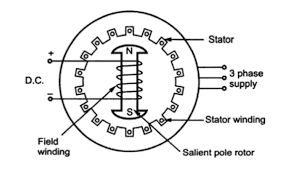In the world of electrical engineering, synchronous speed plays a crucial role in the operation of alternating current (AC) motors. This article aims to understand What is Synchronous Speed?, its significance, and how it relates to AC motors.

Table of Contents
What is Synchronous Speed?
It refers to the rotational speed of the magnetic field within the stator of an AC motor. It is the speed at which the rotating magnetic field produced by the motor’s stator poles moves. Synchronous speed is measured in revolutions per minute (RPM) or cycles per second (Hz) and is determined by the frequency of the power supply and the number of poles in the motor.
Synchronous Speed Calculator
Relationship with Power Supply Frequency
It is directly proportional to the frequency of the power supply. In AC motors, the frequency of the power supply is typically fixed, and the synchronous speed remains constant for a given motor design. For instance, in countries with a 60 Hz power supply, the synchronous speed for a four-pole motor would be 1800 RPM.
Relationship with Motor Pole Count
The number of poles in an AC motor also affects its synchronous speed. The poles are created by the winding configuration in the stator. The higher the number of poles, the slower the synchronous speed will be. Conversely, a motor with fewer poles will have a higher synchronous speed. This relationship is essential when selecting a motor for a specific application, as it determines the motor’s operating characteristics.
Significance
It is a critical parameter for AC motors because it determines the motor’s ability to maintain synchronization with the power supply frequency. When the motor’s actual speed matches the synchronous speed, it is said to be running synchronously. This synchronization is vital for motors used in applications where precise speed control and accurate timing are required.
Deviation from Synchronous Speed
In real-world scenarios, AC motors may not always operate at synchronous speed. The difference between the actual speed and synchronous speed is called slip. Slip is usually expressed as a percentage and represents the motor’s operating speed relative to its synchronous speed. Motors with higher loads or varying external conditions tend to experience greater slip.
Applications and Practical Implications
Understanding this concept is crucial for various applications. AC motors running at synchronous speed are commonly used in power generation, where they rotate the generators to produce electricity at a fixed frequency. Additionally, synchronous speed is essential in applications such as industrial machinery, electric vehicles, and HVAC systems.
So, What is Synchronous Speed?
It is a fundamental concept in the field of electrical engineering, specifically in AC motor operation. It represents the rotational speed of the magnetic field within the motor’s stator and is determined by the power supply frequency and the number of poles in the motor. By maintaining synchronization with the power supply, AC motors can achieve precise speed control and accurate timing, making synchronous speed a crucial parameter in numerous applications. Understanding this concept empowers engineers and technicians to make informed decisions when designing, operating, and troubleshooting AC motor systems.
Important Links